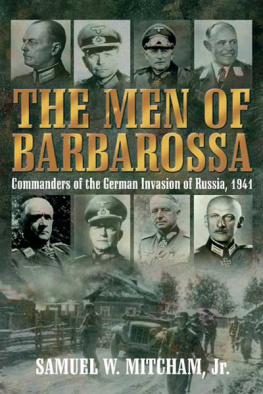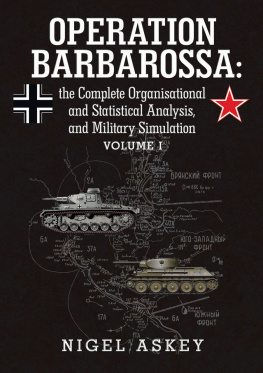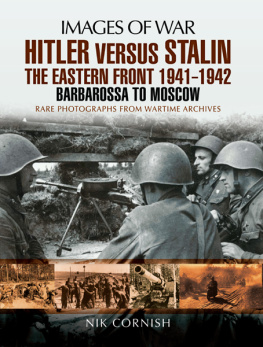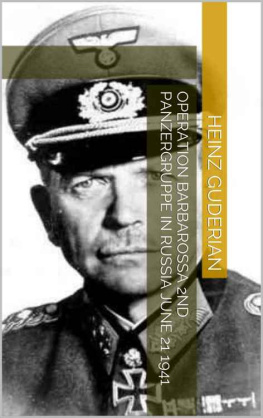

Published in the United States of America in 2009 by CASEMATE
908 Darby Road, Havertown, PA 19083
and in the United Kingdom by CASEMATE
17 Cheap Street, Newbury, Berkshire, RG14 5DD
2009 by Samuel W. Mitcham, Jr.
ISBN 978-1-935149-15-6
Cataloging-in-publication data is available from the Library of Congress and from the British Library.
All rights reserved. No part of this publication may be reproduced, stored in a retrieval system or transmitted, in any form or by any means, electronic, mechanical, photocopying, recording or otherwise, without the prior permission of the publishers.
Printed and bound in the United States of America.
10 9 8 7 6 5 4 3 2 1
For a complete list of Casemate titles, please contact:
United States of America
Casemate Publishers
Telephone (610) 853-9131, Fax (610) 853-9146
E-mail casemate@casematepublishing.com
Website www.casematepublishing.com
United Kingdom
Casemate-UK
Telephone (01635) 231091, Fax (01635) 41619
E-mail casemate-uk@casematepublishing.co.uk
Website www.casematepublishing.co.uk
MAPS
PREFACE
The purpose of this book is to tell the story of Operation Barbarossa and the men who directed it. This objective is massive in scope because Barbarossa, the German invasion of the Soviet Union, was massive in scale, arguably the largest military operation in history. In the single Battle of Kiev, for example, the Red Army lost twice as many men killed as the United States suffered during the entire Vietnam War. Soviet losses in prisoners alone exceeded the size of the entire U.S. Army in Vietnam at the height of its deployment. The Soviets suffered nearly as many losses a month later, at Bryansk and Vyazma, as the Germans closed in on Moscow. Launched across a north-south axis that spanned the width of Eurasia, Operation Barbarossa involved millions of soldiers and countless fighting vehicles. It also changed the world forever.
Before Barbarossa, the German Wehrmacht (German armed forces, 19351945) seemed invincible, and its supreme commander, Adolf Hitler, seemed to be an unstoppable force of nature. No one, it seemed, could check the Fuehrer, much less defeat him. (The Battle of Britain, of course, was seen as a defeat for the Luftwaffe, rather than the Wehrmacht. The German Army was still undefeated, and it was by no means clear in the spring of 1941 that the German pilots would not yet finish off the United Kingdom.) Barbarossa changed all of that. By the end of 1941, Allied victory seemed to be a very real possibility. Few would have bet on it 16 or 17 months before.
Operation Barbarossa was truly staggering in its magnitude. Wars, however, are not fought by numbers; they are fought by men, and this is where The Men of Barbarossa comes in. Its goal is not only to tell the story of the invasion, but to tell the history of some of the men behind it. Very often, writers stereotype German officers into two categories: Prussian gentlemen or Nazi monsters. There were, of course, bothbut there were also varying shades of gray. I hope that my humble efforts contribute to a deeper understanding of what happened in 1941, why it happened, who made it happen, and what went right or wrong.
I would like to thank Melinda Matthews, head of the Interlibrary Loan Department at the University of Louisiana at Monroe (also known as the Cultural and Intellectual Center of the Western Hemisphere) for all of her help, as well as various employees at the Bundesarchiv/Koblenz, the Bundesarchiv/Freiburg, the U.S. National Archives, the War College, the United States Army Military History Institute, and the U.S. Air Forcess Air University Archives. Thanks also go to the late Theodor-Friedrich von Stauffenberg, who left me his papers, as well as dozens of German Army 201 files (i.e., personnel records). Thanks also go to Colonel Ed Marino, Colonel John Angolia, and the late Dr. Waldo Dalstead for sharing their photographs with me and for allowing me to duplicate them. I alone am responsible for any mistakes.
Last but not least, thanks go to my wife, Donna, and to my children, Lacy and Gavin, for putting up with my literary efforts all of these years.
Dr. Samuel W. Mitcham, Jr.
Monroe, Louisiana
March 9, 2009
CHAPTER I
SETTING THE STAGE: THE WEHRMACHT, 19331941
When Adolf Hitler came to power on January 30, 1933, the German Reichswehr (armed forces) had two branches: the Reichsheer (army) and the Reichsmarine (navy). According to the Treaty of Versailles, which ended World War I, the army was limited to 100,000 men (4,000 of whom could be officers), while the navy was limited to 15,000 officers and men. Of the four innovative weapons of World War Itanks, airplanes, poisonous gas, and submarinesthe Reichswehr was denied all four.
Hitler began his secret military expansion almost as soon as he achieved power. On March 9, 1935, he announced the existence of the Luftwaffe, which his cronies Hermann Goering and Erhard Milch had been building for some time. The reaction of Germanys potential enemies (primarily the United Kingdom and France) was so tepid as to be almost nonexistent. This encouraged Hitler, who renounced the Treaty of Versailles (which the Germans called the Versailles Diktat ) a week later. He was now free to pursue his military buildup in even greater earnest.
Because he and his Nazi paladins considered themselves revolutionaries, he also tended to embrace revolutionary military concepts, such as terror bombing and the blitzkrieg (lightening warfare). The same day Hitler renounced the Treaty of Versailles, the German Army activated the first three panzer divisions.
The military entity Hitler used to expand, recruit, and train his armies was the Wehrkreis the German military district, which had served the Second Reich well. (Its counterpart in the Luftwaffe was the Luftgau or air district.) By August 26, 1939, when the Home or Replacement Army was created to control the Wehrkreise (also spelled Wehrkreisen ), four waves of divisions had been created. These Hitler used to conquer Poland. Thirty-one more waves would be formed and sent into action by January 1945, along with several divisions that did not belong to specific waves. By 1943, there were 18 Wehrkreise forming and/or training German divisions: I, II, III, IV, V, VI, VII, VIII, IX, X, XI, XII, XIII, XVII, XVIII, XX, Bohemia and Moravia (in what had been Czechoslovakia), and the Wehrkreise General Gouvernement, in what had been Poland. Map 1.1 shows the Wehrkreise and their territorial responsibilities in 1939. Map 1.2 shows the Wehrkreise after the conquests of Poland, Belgium, and France.
In early 1938, it was discovered that Field Marshal Werner von Blomberg, the defense minister, had married a prostitute. He was forced to retire in disgrace. Heinrich Himmler and his deputy Reinhard Heydrich chose this moment to bring trumped-up charges of homosexuality against the non-Nazi commander-in-chief of the army, Colonel General Baron Werner von Fritsch. Although later exonerated, Fritsch was also forced to resign. Hitler took advantage of this situation to end the corporate independence of the army, place it solidly under Nazi control, and simultaneously set up Germanys command structure for the next war. On February 4, 1938, he named himself Supreme Commander of the Armed Forces ( Wehrmacht ). His new chief executive officer would be General of Artillery (later Field Marshal) Wilhelm Keitel, who held the title commander-in-chief of the High Command of the Armed Forces ( Oberkommando der Wehrmacht or OKW).










